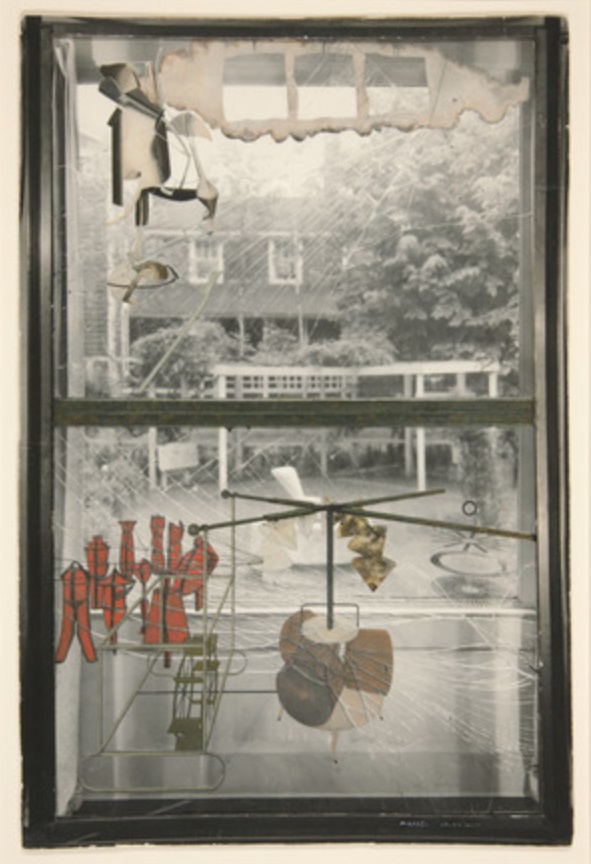1. Architectural Performance
Through Duchamp’s Large Glass
 Duchamp plays chess with a nude Eve Babitz, Duchamp Retrospective, Pasadena Art Museum, California. 1963.
Duchamp plays chess with a nude Eve Babitz, Duchamp Retrospective, Pasadena Art Museum, California. 1963.
LV / 2018
From Architectural Performance Through Duchamp’s Large Glass, 2018
By the 1930’s Marcel Duchamp continued experimenting with technical objects exploring the interplay between art and design. Duchamp’s use of mechanical equipment enhanced the everyday object at the fulcrum of his work. The Bride Stripped Bare By Her Bachelors, Even (The Large Glass), known for her transparency, and eroticism is commonly talked about being a philosophical piece of work. Most historians and critics take an art analysis approach and leave out the simple architectural discussion to which Duchamp worked with the most — the everyday object. In this context; the window, in relation to the total everyday objects he chooses. The subject of his flirtation with architecture has been largely overlooked. Duchamp’s research methods such as his technical instructions, planning, and notes, are an offset and quite loosely based of those plans and technical drawings of an architect. This paper will bring the technical and biotechnical distinction of the canonical art work of The Large Glass in its relation towards an architectural discussion, the pieces from which the piece came from, to instruct the technical aspect of glass made in 1927, and to call out the frequent misconception to which Duchamp’s work can be analyzed architecturally.
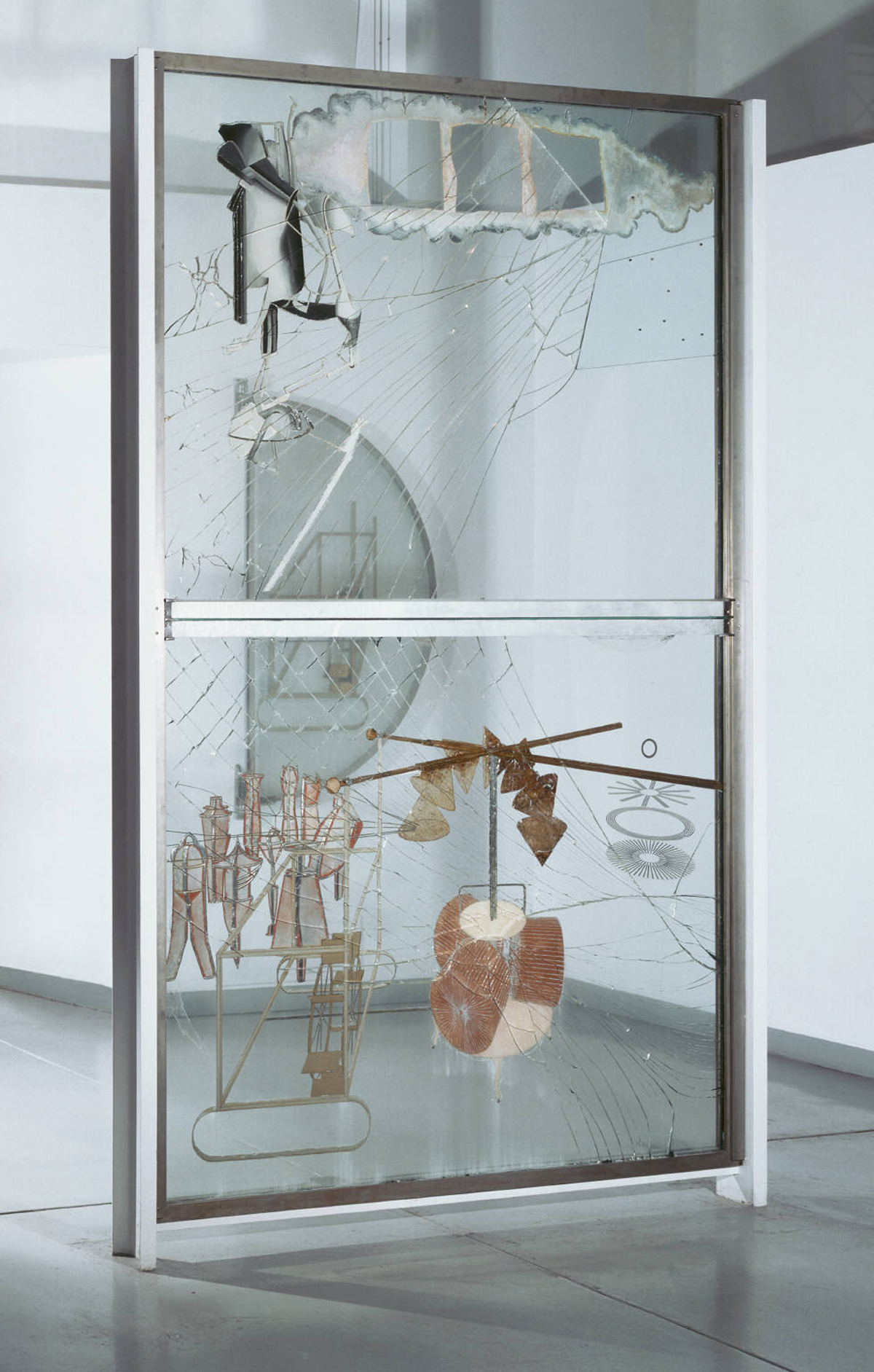
The Bride Stripped Bare by Her Bachelors, Even. Marcel Duchamp, 1915-1923.
Philadelphia Museum of Art.
The Instructions
First, a biographical narrative that includes instructions how the piece was produced. The Bride Stripped Bare of Her Bachelors, Even or The Large Glass is formed by the construction between the window and the piece’s title. Two glass panels set above the other, attached by an aluminum frame. Made in the United States, North and Central America. Date: 1915-1923. Medium: Oil, varnish, lead foil, lead wire, and dust on two glass panels. The Dimensions sit at 9’-1¼”x 5’-3 ⅜”. Oil, varnish, lead wire, lead foil, aluminum foil, wood and a steel frame. Duchamp worked at a ¼” scale. Duchamp worked on this when he was only 27 years old as a newcomer to New York. Set like the instructions of a play, it describes the erotic tension between the enigmatic bride in the upper panel, and her none uniformed, hungry and impatient bachelors below. Most like to analyze the description of the sexual narrative between that of machines so closely attached to persons, yet having the machines placed as characters. As her “bachelors” or characters in the lower panel are stricken by the barrier of the aluminum encasing in a desperate act the question begging from who she will choose; it is about how the female in the portrait succumbs and releases her desire “in a milky way-like cloud”, which ultimately is the consideration of her downfall. The piece shattered in transit following an exhibition at the Brooklyn Museum in 1926-27, where the two panels broke. It was purchased in 1918 by collector Walter C. Arensberg. Much like Duchamp’s The Large Glass, which imitates a photograph at a larger scale. As patrons and viewers are able to see each other from across the piece. Distortion is also at play for the abrupt cracking that happened as the piece was being shipped over. Duchamp declared it definitively unfinished in 1923. 10 years would pass before Duchamp repaired the glass fragments, laboriously securing them between new panes and housing the fabrication in an aluminum frame. He declared it finished with its broken cracks.
There have been many examinations of Large Glass to be about science, philosophy, a deep interpretation of previous and existing art forms, but nothing about architecture. Duchamp was in favor of motion and movement and his character's qualities that experience of machines moving, exhausting, vibrating. “The Glass” together with his readymades were so closely associated with its development as commonly manufactured items that Duchamp promoted to the status of works of art, simply by selecting and signing them, are primary sources for the conceptual approach that has come to dominate art. Is it so odd that he moved to America in the middle of WWII? Directly relocating himself in the system of war, mechanics, and paradoxical illusion of placement. Duchamp never ran away from art, he only wanted to be near to the very things that defined his art; mechanical products, machines, and modes of production. Duchamp wanted to be around the architectural components that defined his art works. Possibly why he considered The Large Glass and Étant donnés to be the masterpieces of his work where they were constructed and manufactured in his new home of New York. On “The Large Glass” he paints machines, and retains the machines and objects he so frequently uses. Instead of painting people, he paints machines. Instead of using a canvas, he uses a window from a building or a found glass object. Perhaps unusual for an artist to choose machines as the fulcrum of their work, somehow these objects entrap the deepest regions of our consciousness. The object has been ignored in the placement of Duchamp’s choosing of the piece and instead fetishisted to which he painted on.

Glass and Windows
Glass is a non-crystalline amorphous solid that is often transparent and has widespread practical, technological, and decorative usage in, for example, window panes, tableware, and optoelectronics. Glass is composed of a chemical compound silicon dioxide (SiO2), sodium oxide (Na2O) from sodium carbonate (Na2CO3), calcium oxide, also called lime (CaO). Glass provides an optical transparency which transmit, reflect and refract light. In its chemistry, silicates come from rock forming and constructed from minerals including feldspar, mica, and quartz. Oxides are any compound formed with oxygen. The valences of oxides are born when an oxygen bound with an organic compound. If attracted, the oxygen creates a new chemical compound then the true oxide is born. Natural compounds birth synthesis. Generally, glass is used for optics. Glass is also considered for reflection which was seen as a mysterious object imitating the reflections of a pool of water. Glass is any of a large class of materials with highly variable mechanical and optical properties that solidify from the molten state without crystallization. In its chemistry, it is a hard brittle transparent material consisting of metal silicates.
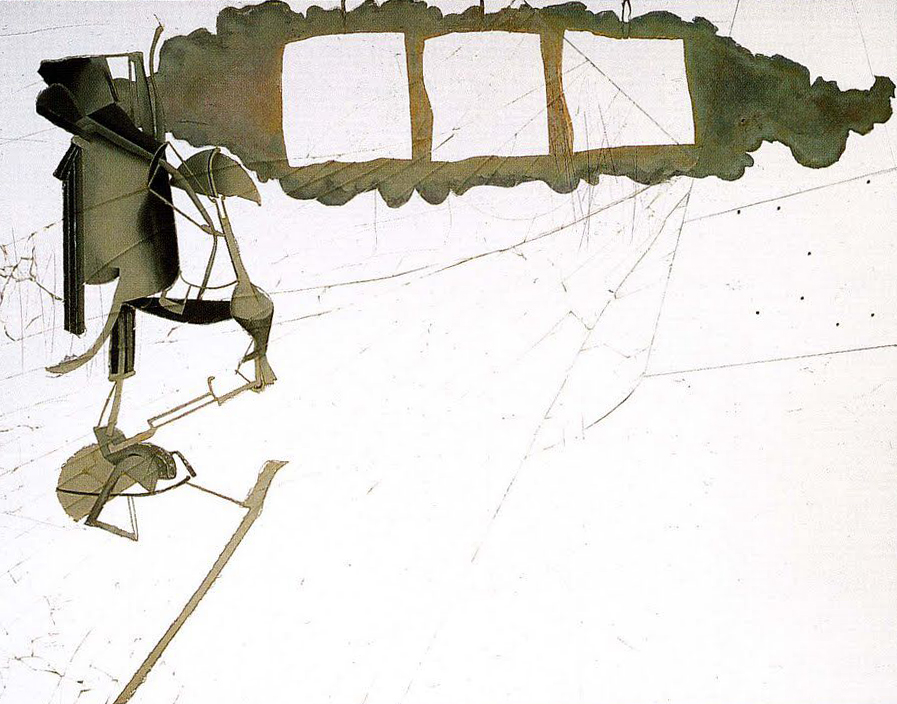
The Bride.
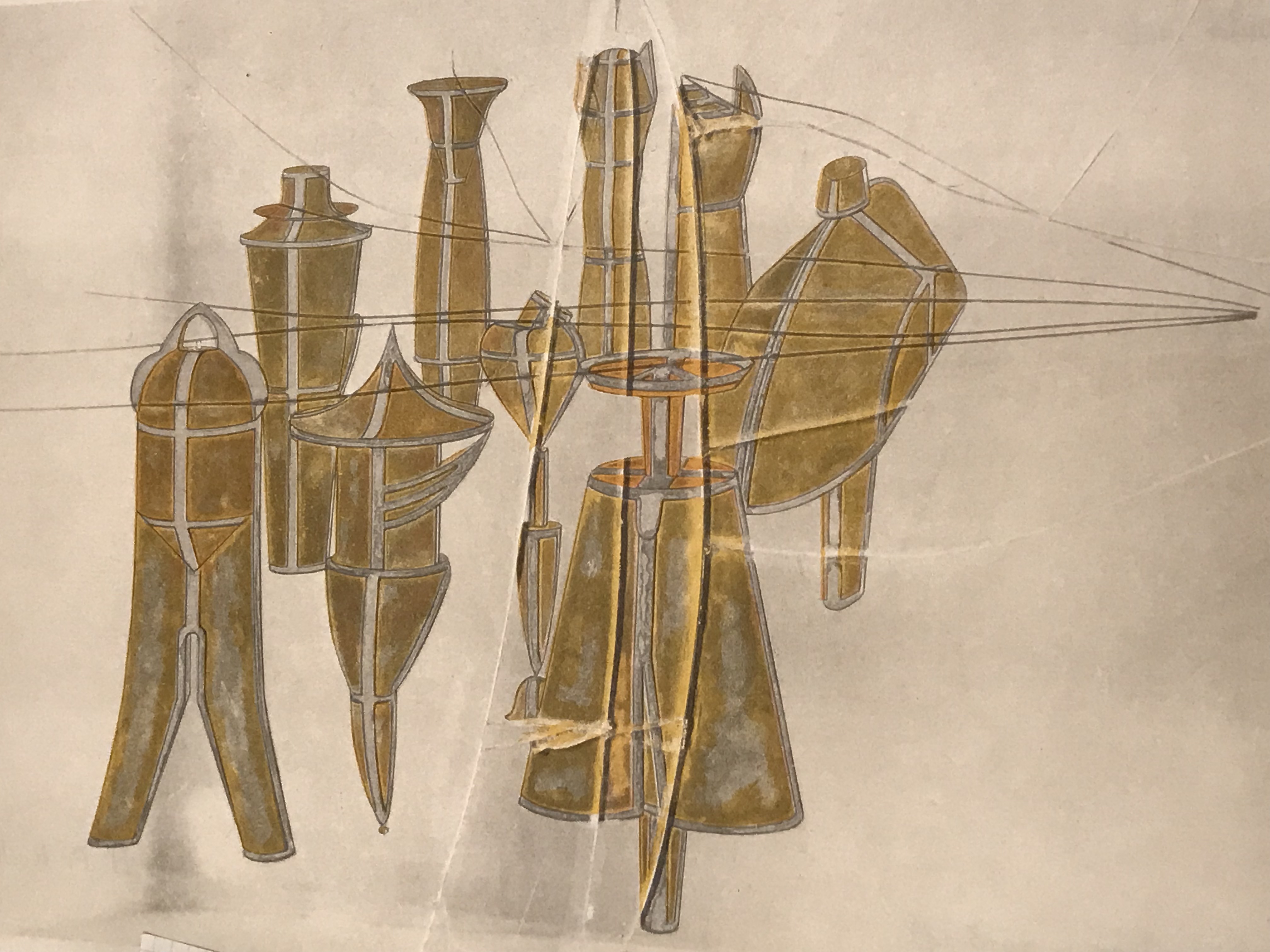 Her Bachelors.
Her Bachelors. Made from fused oxides such as silicon dioxide, lime. Glass is a prime material in everyday usage. Its meaning, although durable, also contains its restraints. Much like the fabric of human beings, it is not perfect which makes it the perfect material. It is fragile, able to break which causes for many of the analogies we use commonly in language as a fourfold of a barrier as a continuing material. There are two types of glass commonly manufactured from 1838-1930, and 1930 on. 1) Leblanc soda glass contains the process for the manufacture of sodium carbonate from common salt. Window glass is made using Leblanc soda is a soda-lime-silica glass which contains very low levels of impurities compared with any of the earlier plant-ash glasses. After 1835, glass contained little or no phosphorus often producing a stained color. 2) From the 1930’s on, mechanized glass. As Leblanc glass was commonly used during these years, it is supposed Duchamp used it from a Leblanc soda glass. After this quite technical description, I am not quite sure that calling out the fallacy of “Large Glass” is related to an architectural agenda. Here I have only presented what the silicone of glass prescribes towards the chemicals of an architectural component. If we equate vision to glass according to its transparency, Duchamp was less interested in the naturalization of vision. However, the use of glass as a product to see-through to get that vision which we call a window. In a note, Duchamp wrote about Shop Windows, encasing a purveyor and observation point of view, yet only relevant towards an architectural language.
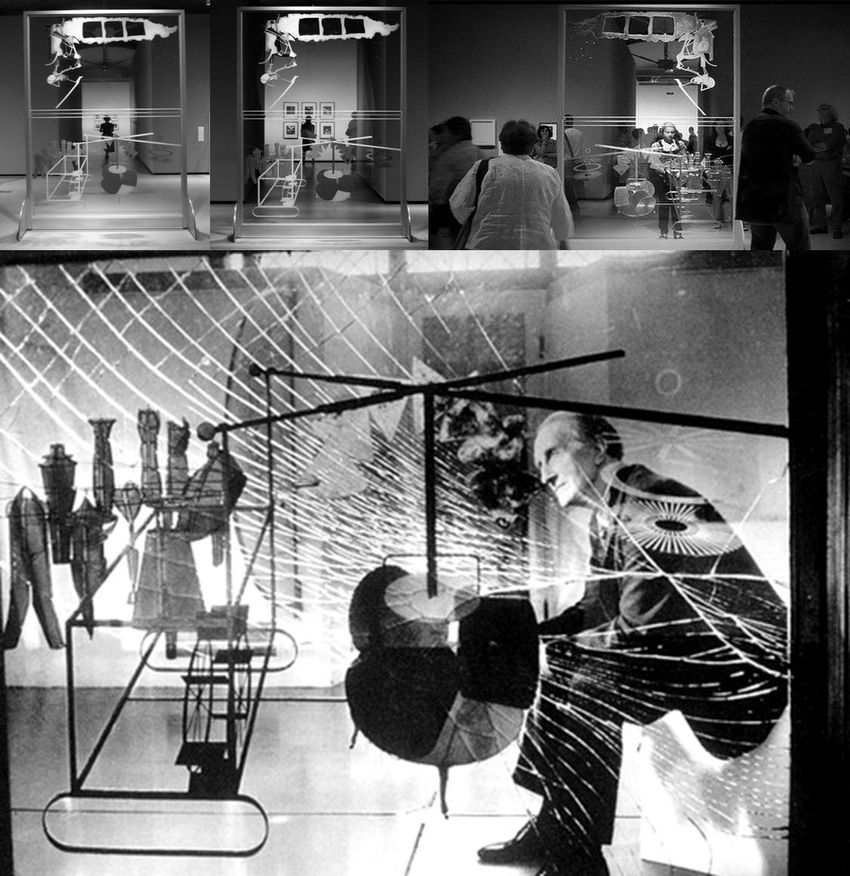
Le Grand Verre, Marcel Duchamp.
“The question of shop windows. To undergo the interrogation of shop windows. The exigency of the shop window.”
The shop window proof of the existence of the outside world. When one undergoes the examination of the shop window, one also pronounces one's own sentence. In fact, one’s choice is “round trip”. From the demands of the show windows, from the inevitable response to shop windows, my choice is determined. No obstinacy, ad absurdum, of hiding the condition through a pane of glass with one or many objects in the shop window. The penalty consists in cutting the pane and in feeling regret as soon as the possession is consummated. Q.E.D.” The Q.E.D. is the confirmation of proof. The theme of collisions was so central to the glass.
Windows and shopping become an economic relevance in the Duchampian world. Searching, seeking, buying product materials and machinery like a good capitalist is the letting guard down of accepting the daily world of trade. Buying and desire in objecthood is focused on a capital conundrum. “Why buy when there are more options? Why see one bride/bachelor when you can see many? Maybe I will wait til it’s on sale? I will wait and see...” Owning the everyday fabric of the mind frame of capital. By owning his world, he was also able to destroy instructions of the art institution. “Why paint on a canvas, when you could so easily paint on glass?” The process of visual perception is also connected within the way we use them. Symbolism and imagery of glass is no less important to understand how these operations are ingrained in the fabric of our lives. There are over a hundred idioms used for the term “glass”. Glass is a fabric of common language with use of metaphors “glassy eyed”, “glass ceiling” “glass half empty, half full”. It also is directed towards vision and clarity. “Glaze over”, “glare” “glance”. Literally the term “trompe l oeil” means “a window to the world”, oddly was used as a painting on canvas as literal terms towards painting. Perhaps this is no less Duchamp’s way of being literal of the Large Glass but also turning his back towards painting. Windows can open and close. They can let air in and out. The device allows us to see and perceive outside from inside. Mechanizing art comes to negotiate the slippery boundary between seeing and vision. Through the apparatus of Duchamp’s glass window, revealing becomes a sequential means of architectural based medial transformations.

Sketch of the Cemetery of Uniforms and Liveries, Marcel Duchamp.
Duchamp Playing The Architect
There is a truly fundamental dichotomy between the art of Duchamp’s Large Glass, and architecture. The subject of his flirtation with architectural design has been largely overlooked. Duchamp’s research methods such as his technical instructions, planning and notes, are an offset and quite loosely based on those plans and technical drawings of an architect. The difference is that he had no training as an architect, but must have been an actor in the illustration of “The Large Glass” production. As Molly Nesbit established in The Language of Industry Duchamp’s technique was rooted in the geometrically oriented drawing methods he learned in the French public schools. The methods he learned was a response to a perceived crisis in French industrial design drew upon the geometry of mechanical drawing. The model of the mechanical drawing was even more important for Duchamp who would refer directly and repeatedly to defend his escape from traditional painting. His carefully arranged notes and drawings organizing the outline of the work are combined with a number of architectural fragments. In various works, he used dotted lines as a motion of monitoring movements in the machines, or women depicted in his imagery. Modeling from mechanical drawings, geometrical diagrams, and frequent illustrations as sketches into technical experiments on glass. There have been many paintings on glass, such as glass cathedrals, murals tracing ink on glass. For some reason, Duchamp’s work appears to be more esoteric than the usual symphonies of painting on glass.
Duchamp’s Glass is the primary expression of the roots towards an architectural culture. In a multifaceted piece, Large Glass was published in Architectural Record in an essay by Fredrick Keiseler, “Design-Correlation: Marcel Duchamp’s Large Glass” In the essay Keiseler describes how Large Glass is “architecture, sculpture and painting in one.” The use of glass as its material at once expresses space and surface and is seen as an enclosure which he advocates in structure and tectonics. Linking the work from X-ray vision and architectural technology. He concludes the essay by writing the connection towards technological advances in architecture and the construction industry. Duchamp was often upset at the interpretations casted off as photographic representation, he gladly accepted new readings of the work as architectural construction. Duchamp’s use of architectural drawing, collage, model making, and photography is the same tool architects use to speculate and provoke production of an architectural work. In other words, in Duchamp's world, a culture which seeks technical, mechanical, and productionary meanings in a work of art. When we speak of design, we speak of the spiritual component and artistic process of the creative subject- first off is the core of creativity, secondly is defined by our way to relate to things anthropomorphically. How we define ourselves with our objects, and that we are nothing without our objects. The frequent chain of operations in using materials so known, is directly centered on how the human is so intertwined by the technical object. Windows are the machines to the world. They reveal, frame, and inhibit us from seeing. Windows also decenterize us of the opening and closing frames they limit and suggest a barrier towards our existence. Through a series of transfusions, of the technical objects which Duchamp chose vary more important. For those who miss the point of it being an architectural object because it exists in this realm. It is in the syntax of speaking or relating to a topic architecturally that will blossom a picture of belonging to an architectural thought. The use of an architectural object in the artwork prescribes a unique authorship. It might be considered to belong to more than one medium. The window is purely a refracitonary object which we commonly perceive as an optical device. However it obstructs the view and limits frames of the window as a pure object.
The economic relevance is deterministic as Duchamp's products rely on the products themselves. Duchamp didn’t care for optical illusions or painting, but only the picture itself. The ultimate technicality is that Duchamp was able to transfuse art and architecture blindly. The inability for us to see clearly to which the objects he is presenting is a common disconnect of a strange paradoxical language he so frequently produces, but which we so frequently adore.
